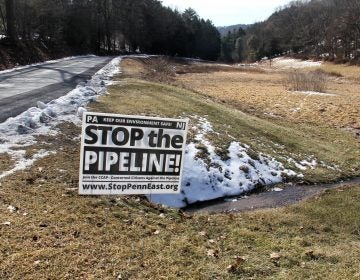N.J., DRBC call on FERC for new environmental review of PennEast
PennEast’s decision to build pipeline in two phases has reignited objections to project, rekindled concerns that have been seething for years

The DEP wants a new environmental impact statement for both phases of the project. (Creative Commons)
This article originally appeared on NJ Spotlight.
–
In the past week, a trio of regulatory agencies have raised new concerns about the latest iteration of the PennEast pipeline project, which the company now wants to build in two separate phases — first in Pennsylvania and then in New Jersey.
In a series of letters to the Federal Energy Regulatory Commission dated March 30, the New Jersey Department of Environmental Protection, Delaware River Basin Commission and U.S. Environmental Protection Agency all suggested the $1 billion project should be subject to rigorous environmental review.
Earlier this year, PennEast Pipeline LLC filed amendments to what had been a 120-mile natural-gas pipeline to ship fuel from Pennsylvania into New Jersey. Its latest proposal called for initially building 68 miles where it has won most of the construction approval, targeting completion by November of next year.
PennEast Phase 2
The other portion in New Jersey would be set to deliver gas in 2023, pending more complicated permit approvals in the state. Thus far, the DEP has refused to review needed permits for the project because of missing field surveys for threatened and endangered species, historical resources, drinking water and freshwater wetlands.
The state agency asked FERC to order a new environmental impact statement for both phases of the project, as well as scrutinize the need for the new pipeline. Opponents of the pipeline have repeatedly argued there is no need to build new capacity, a stance taken by the New Jersey Division of Rate Counsel and others.
“FERC should therefore undertake a fresh analysis as to whether Phase 1 is a ‘stand-alone’ project and, should PennEast pursue a Phase 2 in the future, also undertake a new analysis as to whether Phase 2 is needed,’’ according to the DEP letter to the federal agency.
In addition, the DRBC notified FERC it has determined that the Phase 1 project is subject to review to ensure it complies with the commission’s comprehensive plan. The determination was triggered by the fact that the first phase of the project would cross two reservoirs in Pennsylvania and two state parks.
Is PennEast really necessary?
In another letter from the Region III office of the EPA, PennEast was advised to include in the environmental assessment a clear justification of the underlying “purpose and need’’ for the pipeline.
PennEast does not anticipate the letters from the regulatory agencies will result in a delay for the project, according to Pat Kornick, a spokeswoman for PennEast. FERC recently issued the environmental review schedule, which clearly keeps the project on track for Phase 1 to be in service in November 2021.
Jeff Tittel, director of the New Jersey Sierra Club, had another perspective. “All of these agencies are saying to FERC, you have to do your job.’’ He predicted the battle over the pipeline will go on for another two years.
The project, widely opposed by local groups and environmentalists on both sides of the Delaware River, aims to deliver cheap natural gas to customers in both states. The company has been trying to win approval for the pipeline for the past five years.
WHYY is your source for fact-based, in-depth journalism and information. As a nonprofit organization, we rely on financial support from readers like you. Please give today.




